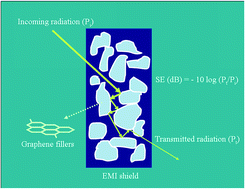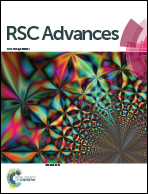Highly efficient electromagnetic interference shielding using graphite nanoplatelet/poly(3,4-ethylenedioxythiophene)–poly(styrenesulfonate) composites with enhanced thermal conductivity†
Abstract
Graphite nanoplatelet (GNP)/conducting polymer (poly(3,4-ethylenedioxythiophene)–poly(styrenesulfonate)) (PEDOT:PSS) composites were synthesized to evaluate their electromagnetic interference (EMI) shielding effectiveness (SE) in the X-band frequency region. The use of a conducting polymer, instead of a conventional polymer, as the base matrix for the composite negates the primary requirement of achieving the percolation threshold to get an appreciable SE. We show that an addition of 0.5 wt% GNPs to PEDOT:PSS takes the EMI SE to ∼30 dB. For 10 and 25 wt% GNP loadings the SE, with dominant absorption, reaches the value of ∼47 and 70 dB, respectively, for a thickness of 0.8 mm. The SE remains nearly constant for the whole frequency range and is the highest achieved so far for non-porous, non-foamy carbon composites of comparable thickness. Owing to their low density, GNP/PEDOT:PSS composites give a high specific EMI SE of up to 67.3 dB cm3 g−1, which is higher compared to even foam structures particularly designed for making low density EMI shields. The drawbacks of foam structures like brittleness and crack formation could also be avoided. Addition of GNPs to PEDOT:PSS results in a several times increase in its pristine thermal conductivity, making it capable of long term use by reducing the chances of chemical degradation through the formation of hot-spots.

- This article is part of the themed collection: Conducting polymers

 Please wait while we load your content...
Please wait while we load your content...